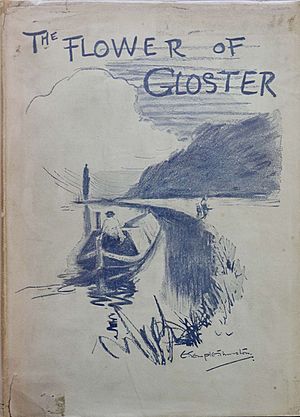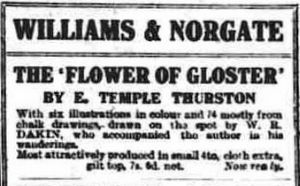The Flower of Gloster facts for kids
The Flower of Gloster is a travel book from 1911 by E. Temple Thurston. He was an Anglo-Irish writer, known for his poems, plays, and books. The book was first published by Williams and Norgate and was quite popular.
It sold so well that a second edition came out just two years later. After being out of print for a long time, it was republished in 1968. Interestingly, a year before that, a children's TV show with the same name was made. It was loosely based on Thurston's original story.
Contents
The Book's Amazing Journey
E. Temple Thurston's book begins with him dreaming of escaping to the quiet English countryside. He wants to buy a narrowboat, which is a long, thin boat used on canals, to explore the country. People he met were a bit doubtful and warned him about canal folk.
He was told to go to Oxford to see a boat called The Flower of Gloster. The boatyard owner there also suggested he hire a "decent fella with an horse" to help him with the locks. Locks are like water elevators that help boats move between different water levels on a canal.
Meeting Eynsham Harry
Thurston met a man named Eynsham Harry. After some long talks at a place called The Nags Head, Harry agreed to be Thurston's guide and helper on the journey. This was the start of their adventure!
Exploring England's Canals
Their journey began on the Oxford Canal. They traveled north past Banbury and then joined the big network of canals in the Midlands. They went through towns like Warwick and Leamington Spa.
As they got closer to the industrial area known as the Black Country, Thurston started to have second thoughts. He asked Eynsham Harry to turn the boat around. This was not an easy thing to do with a narrowboat! They decided to head back through the Stratford-upon-Avon Canal to the peaceful countryside they had just left.
A Walk by the River
At one point, Thurston left the canal to walk along the River Avon. He walked to Evesham and Tewkesbury. There, he met up with Eynsham Harry and The Flower of Gloster again.
Some experts, like David Viner, have looked at the book closely. They wonder if the whole journey happened exactly as Thurston wrote it. It might have been a mix of different trips or visits to the canals. But even if it wasn't all one continuous trip, Viner says the book is still a great read. It shows a lovely picture of England in the Edwardian era and has been important in canal history for over a hundred years.
| First Part (Chapters 1-21) | Second Part (Chapters 22-41) |
|---|---|
| 1: The Discoverer | 22: Pour Passer Doucement Ma Vie |
| 2: Flower of Gloster | 23: Hedgerow Philosophy |
| 3: The Flower of Gloster (continued) | 24: Warwick |
| 4: Oxford | 25: The Gate into the Black Country |
| 5: Oxford (continued) | 26: The Stratford-on-Avon Canal |
| 6: Joseph Pipkin – Owner | 27: Lowson Ford |
| 7: The Bargain | 28: Yarningdale Farm |
| 8: The Beginning of the Journey | 29: The Compleat Angler |
| 9: John Aikin and Anna Laetitia | 30: Preston Bagot |
| 10: Why I Would Like it to have been Anna Laetitia | 31:A Cure for Trippers |
| 11: Shipton-on-Cherwell | 32: An Old Nunnery |
| 12: Shipton-on-Cherwell (continued) | 33: Fladbury Mill |
| 13: Shipton-on-Cherwell (continued) | 34: Wool Gathering |
| 14: Somerton | 35: Apple Blossom |
| 15: The Trade in Old Bits | 36: Tewkesbury |
| 16: Cropredy | 37: The Golden Valley |
| 17: The First Patchwork Quilt – Cropredy | 38: The Golden Valley (continued) |
| 18: The Red Lion – Cropredy | 39: Hard Boiled Eggs |
| 19: The History of Cropredy | 40: Dietetics |
| 20: The Spare Bootlace | 41: The Last Lock |
| 21: School Days |
Different Editions of the Book
Over the years, The Flower of Gloster has been published many times by different companies. Each edition sometimes had special features.
| Year | Publisher | Notes |
|---|---|---|
| 1911 | Williams and Norgate | This was the very first edition. It had pictures by W.R. Dakin. |
| 1912 | Dodd, Mead &Co. | This was the American version. It also had pictures by W.R. Dakin. |
| 1913 | Williams and Norgate | The second edition. Still with pictures by W.R. Dakin. |
| 1918 | Chapman and Hall | The third edition, but this one didn't have any pictures. |
| 1968 | David & Charles | The fourth edition. This one used Thurston's own original photographs. |
| 1970 | Rupert Hart-Davis | This edition was connected to the TV show. It had pictures from the TV series. |
| 1972 | David & Charles | The fifth edition, again with Thurston's original photos. |
| 1984 | Alan Sutton Publishing | The sixth edition. It had Thurston's photos and other old pictures. It also had notes by David Viner. |
| 2004 | Ronald Crowhurst | A photo book by John Kemplay, exploring Thurston's journey. |
How the Book Inspired Others
Thirty years after The Flower of Gloster was published, a historian named L.T.C. Rolt wrote his own book called Narrow Boat. He loved Thurston's book and said it was one of the best canal books he owned. He noted it was one of the only professional accounts of canal life from that time.
The Book's Illustrations
The first edition of The Flower of Gloster in 1911 had six beautiful watercolor paintings and many line drawings. These were all done by a Scottish artist named W.R. Dakin. He based his artwork on photographs taken by the author, Temple Thurston.
These illustrations were a big part of why people liked the book so much. Reviewers from newspapers like The Westminster Gazette and The Scotsman praised Dakin's artwork, calling it "sincere" and "charming."
Later editions of the book, like the one from 1968 edited by L.T.C. Rolt, changed the illustrations. Instead of Dakin's watercolors, they used eight of Temple Thurston's original photographs. The 1984 edition also used Thurston's photos, mixed with many newer pictures. The editor, David Viner, thought this gave the book a "period feel," showing what life was like back then.
The American Version
In 1912, an American version of the book was published by Dodd, Mead and Company. This version was almost the same as the British one. The only main difference was the cover design. The original British cover had an 'Art Deco' style. The American cover was changed to show a boat that looked more like what Americans thought a canal barge should look like.
The TV Show: The Flower of Gloster
In 1967, Granada TV created a 13-part children's TV series called The Flower of Gloster. It was loosely based on Thurston's book.
The Story of the TV Show
In the TV series, a family's father, who owns a boatyard, becomes ill. His oldest son, Dick, along with his younger siblings, 10-year-old Michael and 12-year-old Elizabeth, offer to deliver a narrowboat for him. The boat is, of course, The Flower of Gloster.
Their journey is a long one, about 220 miles, heading south. Along the way, they meet new friends and face many challenges and dangers. The show takes viewers through the beautiful and changing landscapes of the British countryside. Their adventure takes them from Wales, through England's canals, all the way to the Pool of London near Tower Bridge.
Behind the Scenes
This TV series was special because it was the first one from Granada TV to be filmed in color. However, it was first shown on TV in black and white. Professional actors like Richard O'Callaghan and Annette Robertson played some of the roles. Real-life brother and sister, Elizabeth and Mike Doherty, played the younger children. Many real canal people, who were becoming rare at the time, also appeared in the show.
A few years after the TV series, the producer, Bill Grundy, wrote a book based on the show. Grundy wanted the series to be educational as well as adventurous. He included information about geology and wildlife. He said he got the idea for the show after visiting a boat rally near his home in Marple.



